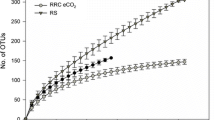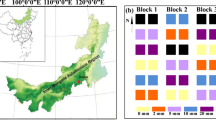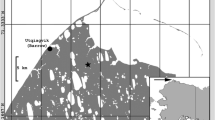Abstract
Elevated CO2 generally increases plant productivity, and has been found to alter plant community composition in many ecosystems. Because soil microbes depend on plant-derived C and are often associated with specific plant species, elevated CO2 has the potential to alter structure and functioning of soil microbial communities. We investigated soil microbial community structure of a species-rich semi-natural calcareous grassland that had been exposed to elevated CO2 (600 μL L−1) for 6 growing seasons. We analysed microbial community structure using phospholipid fatty acid (PLFA) profiles and DNA fingerprints obtained by Denaturing Gradient Gel Electrophoresis (DGGE) of 16S rDNA fragments amplified by the Polymerase Chain Reaction (PCR).
PLFA profiles were not affected by CO2 enrichment and the ratio of fungal and bacterial PLFA did not change. Ordination analysis of DNA fingerprints revealed a significant relation between CO2 enrichment and variation in DNA fingerprints in summer (P=0.01), but not in spring. This variation was due to changes in low-intensity bands, while dominant bands did not differ between CO2 treatments. Diversity of the bacterial community, as assessed by number of bands in DNA fingerprints and calculation of Shannon diversity indices, was not affected by elevated CO2.
Overall, only minor effects on microbial community structure were detected, corroborating earlier findings that soil carbon inputs did probably change much less than suggested by plant photosynthetic responses.
Similar content being viewed by others
References
Allen M F, Andrews J A, Finzi A C, Matamala R, Richter D D and Schlesinger W H 2000 Effects of free-air CO2 enrichment (FACE) on belowground processes in a Pinus taeda forest. Ecol. Appl. 10, 437–448.
Bardgett R D, Hobbs P J and Frostegård A 1996 Changes in soil fungal:bacterial biomass ratios following reductions in the in-tensity of mangement of an upland grassland. Biol. Fertil. Soils 22, 261–264.
Basile F, Voorhees K J and Hadfield T L 1995 Microorganism gram-type differentiation based on pyrolysis-mass spectrometry of bacterial fatty acid methyl ester extracts. Appl. Environ. Microbiol. 61, 1534–1539.
Berntson G M and Bazzaz F A 1996 Belowground positive and negative feedbacks on CO2 growth enhancement. Plant Soil 187, 119–131.
Bligh E G and Dyer W J 1959 A rapid method of total lipid extraction and purification. Can. J. Biochem. Phys. 37, 911–917.
Bossio D A, Scow K M, Gunapala N and Graham K J 1998 Determinants of soil microbial communities: Effects of agricultural management, season, and soil type on phospholipid fatty acids profiles. Microbial Ecol. 36, 1–12.
Bruce K D, Jones T H, Bezemer T M, Thompson L J and Ritchie D A 2000 The effect of elevated atmospheric carbon dioxide levels on soil bacterial communities. Glob. Change Biol. 6, 427–434.
Cardon Z G 1996 Influence of rhizodeposition under elevated CO2 on plant nutrition and soil organic matter. Plant Soil 187, 277–288.
Darrah P R 1996 Rhizodeposition under ambient and elevated CO2 levels. Plant Soil 187, 265–275.
Diaz S, Grime J P, Harris J and McPherson E 1993 Evidence of a feedback mechanism limiting plant response to elevated carbon dioxide. Nature 364, 616–617.
Ebersberger D, Niklaus P A and Kandeler E 2003 Long-term CO2 enrichment stimulates N-mineralisation and enzyme activities in a calcareous grassland. Soil Biol. Biochem. 35, 965–972.
Frostegård A and Bååth E 1996 The use of phospholipid fatty acid analysis to estimate bacterial and fungal biomass in soil. Biol. Fertil. Soils 22, 59–65.
Frostegård A, Bååth E and Tunlid A 1993 Phospholipid fatty acid composition, biomass and activity of microbial communities from two soil types experimentally exposed to different heavy metals. Appl. Environ. Microbiol. 59, 3605–3617.
Grayston S J, Cambell C D, Lutze J L and Gifford R M 1998 Impact of elevated CO2 on the metabolic diversity of microbial communities in N-limited grass swards. Plant Soil 203, 289–300.
Griffiths B S, Ritz K, Ebblewhite N, Paterson E and Kilham K 1998 Ryegrass rhizosphere microbial community structure under elevated carbon dioxide concentrations with observation on wheat rhizosphere. Soil Biol. Biochem. 30, 315–321.
Heuer H, Krsek M, Baker P, Smalla K and Wellington E M H 1997 Analysis of actinomycete communities by specific amplification of genes encoding 16S rRNA and gel-electrophoretic separation in denaturing gradients. Appl. Environ. Microbiol. 63, 3233–3241.
Hodge A, Paterson E, Grayston S J, Campbell C D, Ord B G and Killham K 1998 Characterisation and microbial utilisation of ex-udate material from the rhizosphere of Lolium perenne grown under CO2 enrichment. Soil Biol. Biochem. 30, 1033–1043.
Hu S, Firestone M K and Chapin III F S 1999 Soil microbial feed-backs to atmospheric CO2 enrichment. Trends Ecol. Evol. 14, 433–437.
Hu S, Chapin III F S, Firestone M K, Field C B and Chiariello N R 2001 Nitrogen limitation of microbial decomposition in a grassland under elevated CO2. Nature 409, 188–191.
Insam H, Bååth E, Berreck M, Frostegård A, Gerzabeck M H, Kraft A, Schinner F, Schweiger P and Tschuggnall G 1999 Responses of the soil microbiota to elevated CO2 in an artificial tropical ecosystem. J. Microbiol. Meth. 36, 45–54.
Klironomos J N, Rillig M C and Allen M F 1996 Below-ground microbial and microfaunal responses to Artemisia tridentata grown under elevated atmospheric CO2. Funct. Ecol. 10, 527–534.
Leadley P W, Niklaus P, Stocker R and Körner C 1997 Screen-aided CO2 control (SACC): A middle-ground between FACE and open-top chamber. Acta Oecol. 18, 207–219.
Marilley L, Hartwig U A and Aragno M 1999 Influence of an elevated atmospheric CO2 content on soil and rhizosphere bacterial communities beneath Lolium perenne and Trifolium repens under field conditions. Microbial Ecol. 38, 39–49.
Marschner P, Kandeler E, Marschner B 2003 Structure and function of the soil microbial community in a long-term fertilizer experiment. Soil Biol. Biochem. 35, 453–461.
Mayr C, Miller M and Insam H 1999 Elevated CO2 alters commmunity-level physiological profiles and enzymes activities in alpine grassland. J. Microbiol. Meth. 36, 35–43.
Montealegre C M, van Kessel C, Blumentahl J M, Hur H-G, Hartwig U A, Sadowsky M J 2000 Elevated atmospheric CO2 alters microbial population structure in a pasture ecosystem. Glob. Change Biol. 6, 475–482.
Montealegre C M, van Kessel C, Ruselle M P and Sadowsky M J 2002 Changes in microbial activity and composition in a pasture ecosystem exposed to elevated atmospheric carbon dioxide. Plant Soil 243, 197–207.
Morgan J A, Pataki D E, Körner C, Clark H, Del Grosso S J, Grünzweig J M, Knapp A K, Mosier A R, Newton P C D, Niklaus P A, Nippert J B, Nowak R S, Parton W J, Polley H W and Shaw M R 2004 The role of water relations in grassland and desert ecosystem responses to rising atmospheric CO2. Oecologia, in press.
Myzer G, de Waal E C and Uitterlinden A G 1993 Profiling of complex microbial populations by denaturing gradient gel electrophoresis analysis of polymerase chain reaction-amplified genes encoding for 16S rRNA. Appl. Environ. Microbiol. 59, 695–700.
Myzer G and Smalla K 1998 Application of denaturing gradient gel electrophoresis (DGGE) and temperature gradient gel electro-phoresis (TGGE) in microbial ecology. Ant. Leeuw. Int. J. G 73, 127–141.
Niklaus P A 1998 Effects of elevated atmospheric CO2 on soil microbiota in calcareous grassland. Glob. Change Biol. 4, 451–458.
Niklaus P A and Körner C 2004 Synthesis of a six-year study of calcareous grassland responses to in situ CO2 enrichment. Ecol. Monogr., in press.
Niklaus P A, Spinnler D and Körner C 1998 Soil moisture dynamics of calcareous grassland under elevated CO2. Oecologia 117, 201–208.
Niklaus P A, Wohlfender M, Siegwolf R and Körner C 2001a Effects of six years atmospheric CO2 enrichment on plant, soil, and soil microbial C of a calcareous grassland. Plant Soil 233, 189–202.
Niklaus P A, Glöckler E, Siegwolf R and Körner C 2001b Plant-soil carbon fluxes in calcareous grassland under elevated CO2:A combined 13 C pulse labelling/soil physical fractionation study. Funct. Ecol. 15, 235–240.
Niklaus P A, Alphei J, Ebersberger D, Kampichler C, Kandeler E and Tscherko D 2003 Six years of in situ CO2 enrichment evoke changes in soil structure and soil biota of nutrient-poor grassland. Glob. Change Biol. 9, 585–600.
Ogermann P, Spycher B, Schaub D and Sollberger R 1994 Die Landschaftsstruktur im Raum Nenzlingen-geoökologisch gesehen. Regio Basiliensis 35, 91–100.
Rillig M C, Scow K M, Klironomos J N and Allen M F 1997 Microbial carbon-substrate utilization in the rhizosphere of Gutierrezia sarothrae grown in elevated atmospheric carbon dioxide. Soil Biol. Biochem. 29, 1387–1394.
Rillig M C, Field C B and Allen M F 1999 Soil biota responses to long-term atmospheric CO2 enrichment in two California annual grasslands. Oecologia 119, 572–577.
Ringelberg D B, Stair J O, Almeida J, Norby R J, O'Neill E G and White D C 1997 Consequences of rising atmospheric carbon dioxide levels for the belowground microbiota associated with white oak. J. Environ. Qual. 26, 495–503.
Rogers H H, Runion G B and Krupa S V 1994 Plant responses to atmospheric CO2 enrichment with emphasis on roots and the rhizosphere. Environ. Pollut. 83, 155–189.
Rønn R, Gavito M, Larsen J, Jakobsen I, Frederiksen H and Christensen S 2002 Response of free-living soil protozoa and microorganisms to elevated athmospheric CO2 and presence of mycorrhiza. Soil Biol. Biochem. 34, 923–932.
Schortemeyer M, Hartwig U A, Hendrey G R and Sadowsky M J 1996 Microbial community changes in the rhizospheres of white clover and perennial ryegrass exposed to free air carbon dioxide enrichment (FACE). Soil Biol. Biochem. 28, 1717–1724.
ter Braak C J F and Prentice I C 1988 A theory of gradient analysis. Adv. Ecol. Res. 18, 271–317.
ter Braak C J F and Smilauer P 1998 CANOCO Reference Manual and User's Guide to Canoco for Windows: Software for Canonical Community Ordination (version 4). Microcomputer Power, Ithaca, NY, USA. 352p.
Uren N C 2001 Types, amounts, and possible functions of compounds released into the rhizosphere by soil-grown plants. In The Rhizosphere Biochemistry and Organic Substances at the Soil-Plant Interface <nt>Eds.</nt> E Pinton, Z Varanini and P Nannipieri. pp. 19–40. Marcel Dekker, Inc., New York.
White D C, Davis W M, Nickels J S, King J C and Bobbie R J 1979 Determination of the sedimentary microbial biomass by extractable lipid phosphate. Oecologia 40, 51–62.
Wiemken V, Laczko E, Ineichen K and Boller T 2001 Effects of elevated carbon dioxide and nitrogen fertilization on mycorrhizal fine roots and the soil microbial community in beech-spruce ecosystems on siliceous and calcareous soil. Microbiol. Ecol. 42, 126–135.
Williams M A, Rice C W and Owensby C E 2000 Carbon dynamics and microbial activity in tallgrass prairie exposed to elevated CO2 for 8 years. Plant Soil 227, 127–137.
Zak D R, Pregitzer K S, Curtis P S, Teeri J A, Fogel R and Randlett D L 1993 Elevated atmospheric CO2 and feedback between carbon and nitrogen cycles. Plant Soil 151, 105–117.
Zak D R, Ringelberg D B, Pregitzer K S, Randlett D L, White D C and Curtis P S 1996 Soil microbial communities beneath Populus grandientata grown under elevated CO2. Ecol. Appl. 6, 257–262.
Zak D R, Pregitzer K S, Curtis P S and Holmes W E 2000a Atmospheric CO2 and the composition and function of soil microbial communities. Ecol. Appl. 10, 44–59.
Zak D R, Pregitzer K S, King J S and Holmes W E 2000b Elevated atmospheric CO2, fine roots and the response of soil microorganisms: A review and hypothesis. New Phytol. 147, 201–222.
Author information
Authors and Affiliations
Rights and permissions
About this article
Cite this article
Ebersberger, D., Wermbter, N., Niklaus, P.A. et al. Effects of long term CO2 enrichment on microbial community structure in calcareous grassland. Plant Soil 264, 313–323 (2004). https://doi.org/10.1023/B:PLSO.0000047768.89268.8c
Issue Date:
DOI: https://doi.org/10.1023/B:PLSO.0000047768.89268.8c




